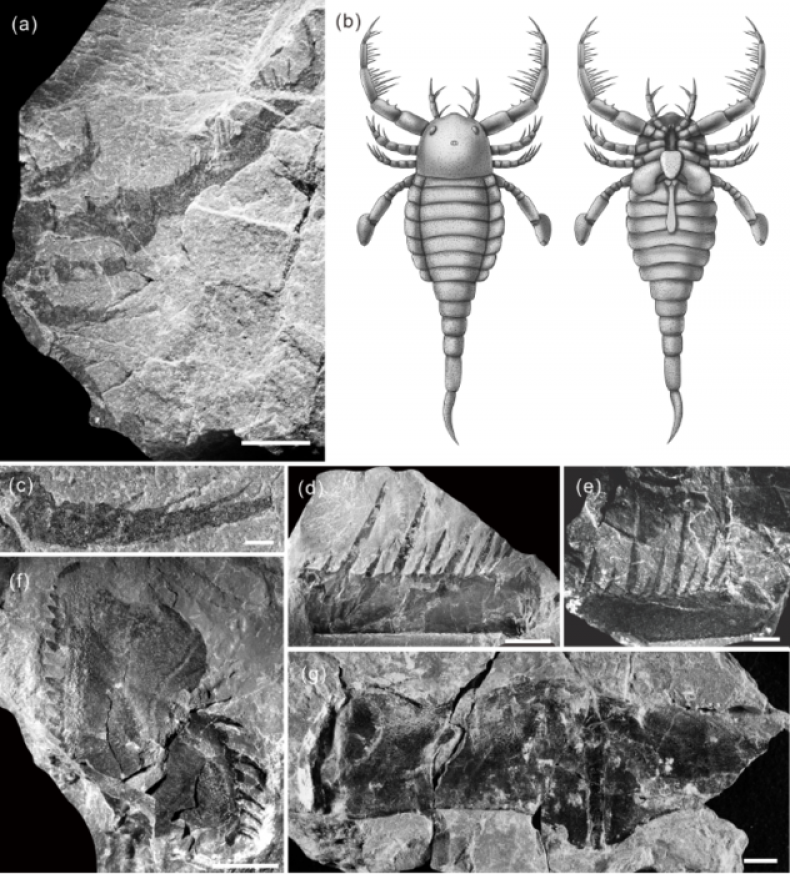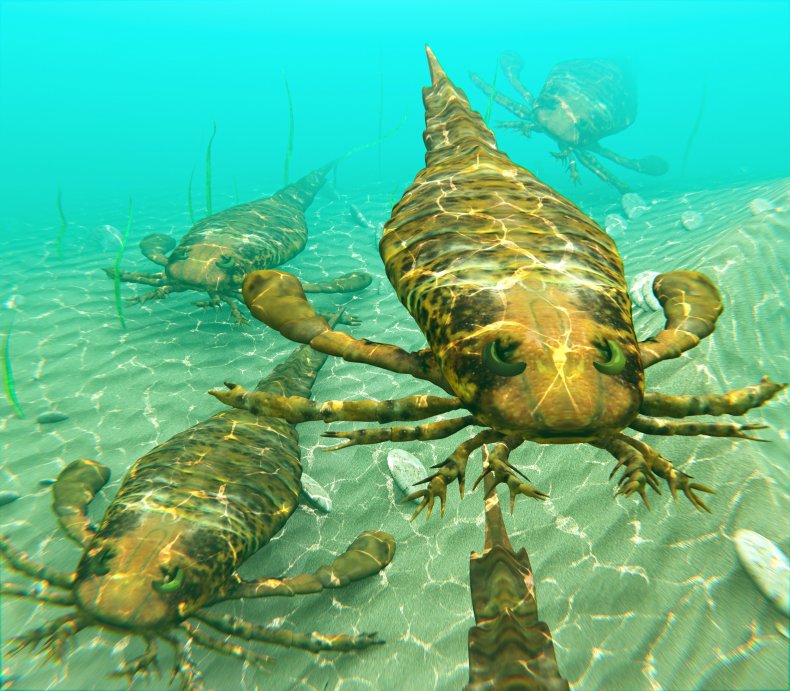BY ROBERT LEA
ON 10/19/21
Researchers in China have found the fossilized remains of a fearsome sea scorpion. The creature grew to over 3 feet in length and had an enlarged back limb covered with an arrangement of spines used for ensnaring prey.
The new creature is part of the mixopterid family of the eurypterids, a group of species known for their specialized front arms or "pedipalps." This family of sea scorpions more closely reflects what we think of as the traditional image of a scorpion, with a large tail and enlarged front claws, and this creature is no exception.
This mixopterid, which has been named Terropterus xiushanensis had front arms covered in spiny protrusions. These appendages were likely used as a "catching basket" used to ensnare prey. Its fearsome enlarged "tail" was tipped with a spear-like appendage.
The three Terropterus fossils discovered, one complete and two incomplete, indicate that the creature could grow to over 3 feet long. This large size is also something that is characterized by other mixopterids.
The team that discovered the eurypterid, the formal name for a sea scorpion, believes that it could have been a top predator in the shallow waters of South China between 444 and 419 million years ago.
This coincides with the Silurian period in Earth's history. Though Eurypterids first enter the fossil record in the Ordovician period between 485 and 445 million years ago, they increased in diversity significantly in the Silurian period. The creatures would be completely extinct by the Permian period of Earth's history, which began 300 million years ago.

Researchers in China have found the fossilized remains of a fearsome sea scorpion. The creature grew to over 3 feet in length and had an enlarged back limb covered with an arrangement of spines used for ensnaring prey.
The new creature is part of the mixopterid family of the eurypterids, a group of species known for their specialized front arms or "pedipalps." This family of sea scorpions more closely reflects what we think of as the traditional image of a scorpion, with a large tail and enlarged front claws, and this creature is no exception.
This mixopterid, which has been named Terropterus xiushanensis had front arms covered in spiny protrusions. These appendages were likely used as a "catching basket" used to ensnare prey. Its fearsome enlarged "tail" was tipped with a spear-like appendage.
The three Terropterus fossils discovered, one complete and two incomplete, indicate that the creature could grow to over 3 feet long. This large size is also something that is characterized by other mixopterids.
The team that discovered the eurypterid, the formal name for a sea scorpion, believes that it could have been a top predator in the shallow waters of South China between 444 and 419 million years ago.
This coincides with the Silurian period in Earth's history. Though Eurypterids first enter the fossil record in the Ordovician period between 485 and 445 million years ago, they increased in diversity significantly in the Silurian period. The creatures would be completely extinct by the Permian period of Earth's history, which began 300 million years ago.

Terropterus xiushanensis recently discovered in fossils discovered in China may have been a fearsome predator in shallow waters around 440 million years ago.NIGPAS
The discovery is an important step in establishing the diversity of creatures that existed during the Silurian period. Currently, very few large predators have been found in the shallow seas of China that existed during that period.
"Our knowledge of mixopterids is limited to only four species in two genera, which were all based on a few fossil specimens from the Silurian Laurussia 80 years ago," said doctoral researcher Wang Bo from the Nanjing Institute of Geology and Palaeontology of the Chinese Academy of Sciences.
Wang Bo is one of the authors of a paper discussing the discovery published in the journal Science Bulletin.
The fact that the fossil record contains such pristinely preserved appendages is important in the discovery of the diverse morphological characteristics of the ancient mixopterids.
Terropterus is the oldest example of a mixopterid discovered and the first of this class of sea scorpion found that would have swum the seas of Gondwana, the supercontinent that broke apart around 180 million years ago.
Four other examples of mixopterid species, described by the paper's authors as "bizarre animals" have been discovered from the Silurian period, but these existed in the Pangea landmass of Laurasia, made up mostly of what is now North America.
The team hopes that future research in Asia may uncover more mixopterids and even additional groups of eurypterids.

The discovery is an important step in establishing the diversity of creatures that existed during the Silurian period. Currently, very few large predators have been found in the shallow seas of China that existed during that period.
"Our knowledge of mixopterids is limited to only four species in two genera, which were all based on a few fossil specimens from the Silurian Laurussia 80 years ago," said doctoral researcher Wang Bo from the Nanjing Institute of Geology and Palaeontology of the Chinese Academy of Sciences.
Wang Bo is one of the authors of a paper discussing the discovery published in the journal Science Bulletin.
The fact that the fossil record contains such pristinely preserved appendages is important in the discovery of the diverse morphological characteristics of the ancient mixopterids.
Terropterus is the oldest example of a mixopterid discovered and the first of this class of sea scorpion found that would have swum the seas of Gondwana, the supercontinent that broke apart around 180 million years ago.
Four other examples of mixopterid species, described by the paper's authors as "bizarre animals" have been discovered from the Silurian period, but these existed in the Pangea landmass of Laurasia, made up mostly of what is now North America.
The team hopes that future research in Asia may uncover more mixopterids and even additional groups of eurypterids.

Eurypterids seen swimming in a group in a stock illustration. Researchers have discovered a new species of Eurypterid or sea scorpion which could have dominated the shallow seas of China around 440 million years ago.AUNT_SPRAY/GETTY
No comments:
Post a Comment